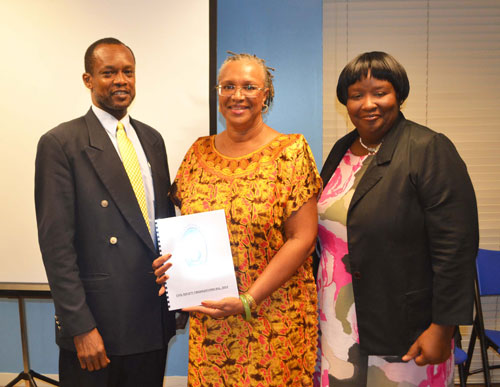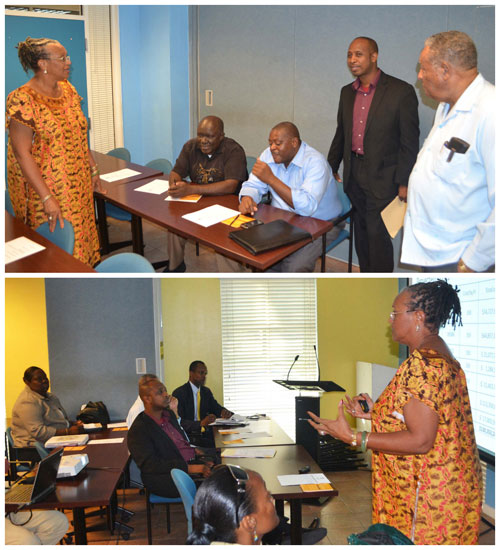|

|
 |
|
Last Updated: Feb 13, 2017 - 1:45:37 AM |
University of The Bahamas Master Plan Calls for Accessible, Welcoming Campuses
By Office of Communication, The College of The Bahamas
Jun 23, 2014 - 3:02:27 PM
|
Email this article
Mobile friendly page
|

Acting President Dr. Earla Carey Baines accepts a copy of the draft Civil Society Organisations Bill under consideration
|
Nassau, Bahamas - Accessible, well defined and welcoming. These are the primary characteristics of the coming University of The Bahamas’ multi-campus community that the Master Plan seeks to achieve, Acting President of The College of The Bahamas Dr. Earla Carey-Baines shared when she addressed Civil Society Bahamas on Thursday, June 19th.
The College is in an extraordinary period of transition as it prepares to embrace university status by July 2015. Its leaders have projected a 25 percent growth in student enrollment over the next ten years, which would mean an overall student population of approximately 6,250 by 2024.
The Master Plan – a blueprint for the physical expansion of the existing Oakes Field and Northern Bahamas campuses – includes in New Providence modernised classroom and laboratory facilities, vast open spaces to support a vibrant campus life, more administrative accommodations and a distinct entrance boulevard to the University, to be erected on Tucker Road between Water Street and Thompson Boulevard.
The campus in East Grand Bahama is intended to serve the higher education needs of the northern Bahamas. New residences for faculty and students, administrative facilities and student assembly areas, accessible to persons of all abilities, will be created.
The guiding principles of the Master Plan for the University of The Bahamas are rooted in the academic, cultural and physical life of the institution. The aim is to have a visible, well defined presence within the communities that the University serves in the fulfilment of its mission.
“Our master planners have told us what we already know – that there is a deficit in classroom and laboratory spaces. We also simply cannot meet the demand for dorms because we simply do not have enough dorm rooms,” explained Dr. Carey-Baines.
“We know that we have a problem with space; we do not have enough athletic, recreational and educational space. Our students do very well, faculty work really hard. Imagine what more they could do if we had more updated facilities. There is a lot more we can do if we simply had the facilities.”

TOP Photo: Acting COB President Dr. Earla Carey Baines chats with members of civil society before the meeting; and BOTTOM photo: Acting COB President Dr. Earla Carey-Baines presents on the Master Plan for the University of The Bahamas
|
The Master Plan also calls for the School of Nursing and Allied Health Professions at the Grosvenor Close Campus, situated on Shirley Street and a stone’s throw away from the Princess Margaret Hospital, to be relocated to the Oakes Field Campus so that the students have easy access to the scientific laboratories and other facilities.
The College Council and senior administrators are planning an aggressive growth agenda – growth in the academic programmes that will address the business, industrial and scientific needs of The Bahamas, expanded research to enhance this country’s competitiveness and more public-private sector partnerships to strengthen the academy’s capacity to support and drive national development.
In addition to new facilities to support a variety of academic programmes in the recording, performing and visual arts, as well as the sciences and small island sustainability disciplines, the Franklyn R. Wilson Graduate Centre is also under construction. Marine science and engineering programmes are planned for the Northern Bahamas Campus and the students who want to pursue agriculture and mariculture will have access to the Bahamas Agriculture and Marine Science Institute in North Andros.
The completion of the blueprint that will guide the physical development of the University is a significant step towards realising the University’s fullest potential. To that end, engaging civil society organisations and non-governmental organisations in the plan for growth is important, just as important as cultivating prospects for philanthropy.
“We are finalising the plan to create a University Zone to formalize our outreach and engagements with the surrounding communities. A national university cannot exist if the persons the University serves do not feel that it belongs to them,” Dr. Carey-Baines said.
Another significant step in the transition process is the enactment of the proposed Act that will bring the University into force. The College’s initial draft of the bill proposes a university that would embody a commitment to national excellence, acknowledge academic freedom, uphold human dignity and promote equitable access to tertiary education. The titular head would be the Chancellor and the President would serve as Vice Chancellor, supported by Pro Vice-Chancellors and other officers, according to the proposed draft.

© Copyright 2014 by thebahamasweekly.com
Top of Page
|
|
 |

|
